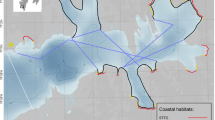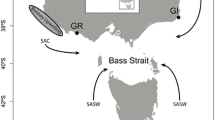Abstract
Increased abundances of a number of seabird species have been found in areas of mussel longline aquaculture (compared to control sites) in a recent study at Bantry Bay, southwest Ireland. The aim of this study was to investigate whether this form of mussel aquaculture also affects the activity budgets and foraging behaviour of these seabirds. Scan-sampling was used to compare seabird activity budgets between three areas of mussel longline aquaculture and three control sites. Foraging activities of Great-Northern Divers Gavia immer, an Annex 1 species under the Euopean Union's Birds Directive, were also compared between sites using focal sampling. The behaviour of gulls (Larus sp.), Cormorants Phalacrocorax carbo, Shags Phalacrocorax aristotelis and Great-Northern Divers (but not auks, Alcidae) differed significantly between areas of mussel aquaculture and control sites in this study. Mussel suspension buoys were heavily utilized by gulls, cormorants and shags as safe perching platforms for preening activities. Gulls also fed extensively on epifauna attached to the buoys. Great-Northern Divers spent more time snorkelling (head submerged in search of food) in mussel sites than in the control sites, however dive duration and visible foraging success rates did not differ significantly between sites. Overall, the environmental impact of mussel suspension culture appears to be positive or neutral on marine bird species occurring at this study site.



Similar content being viewed by others
References
Altmann J (1974) Observational study of behaviour: sampling methods. Behaviour 48:227–267
Anon (2004) Solutions for sustainable mariculture – avoiding the adverse effects of mariculture on biological diversity (CBD Technical Series no. 12). Secretariat of the Convention on Biological Diversity, World Trade Centre, Montreal, Quebec, 52 pp
Baudinet D (1990) Incidence of mussel culture on biogeochemical fluxes at the sediment–water interface. Hydrobiologia 207:187–196
Black KD (ed) (2001) Environmental impacts of Aquaculture. Sheffield Academic Press, London, 214 pp
Boelens RGV, Maloney DM, Parsons AP, Walsh AR (1999) Irelands marine and coastal areas and adjacent seas. An environmental assessment. Marine Institute, Dublin, Ireland, 338 pp
Branco JO, Reuter Braun JR, Verani JR (2001) Seasonal variation in the abundance of Seabirds in areas of mariculture. Braz Arch Biol Technol 44:395–399
Burnell G (1996) The Environmental impact of marine bivalve mollusc exploitation: a brief review of the disturbances caused by mariculture and fishing. In: Giller PS, Myers AA (eds) Disturbance and recovery in ecological systems. Royal Irish Academy, Dublin, pp 84–97
Carter P (1976) Diving rates of Great Northern Diver (Note). Brit Birds 69:495–497
Cote IM, Jelnikar E (1999) Predator-induced clumping behaviour in mussels (Mytilus edulis Linnaeus). J Exp Marine Biol Ecol 235:201–211
Cramp S, Simmons KEL (1977) Handbook of the Birds of Europe, The Middle East and North Africa. The Birds of the Western Palearctic. Oxford University Press, Oxford, 722 pp
Cramp S, Simmons KEL (1983) Handbook of the birds of Europe: the Middle East and North Africa. The birds of the Western Palearctic, vol 3: Waders to Gulls. Oxford University Press, Oxford, 913 pp
Cramp S, Brooks DJ (1985) Handbook of the birds of Europe: the Middle East and North Africa. The Birds of the Western Palearctic. Oxford University Press, Oxford, 960 pp
Crawford CM, Macleod CKA, Mitchell IM (2003) Effects of shellfish farming on the benthic environment. Aquaculture 224:117–140
Davenport J, Black K, Burnell G, Cross T, Culloty S, Ekaratne S, Furness RW, Mulcahy M, Thetmeyer H (2003) Aquaculture: the ecological issues. British Ecological Society/Blackwell Science, Oxford, 89 pp
Davies G, Dare PJ, Edwards DB (1980) Fenced enclosures for the protection of seed mussels (Mytilus edulis L.) from predation by shore-crabs (Carcinus maenus L.). Fish Invest Ser 2 Mar Fish 56:1–14
Dolmer P (1998) The interactions between bed structure of Mytilus edulis L. and the predator Asterias rubens L. J Exp Mar Biol Ecol 228:137–150
Dytham C (2003) Choosing and using statistics, a biologist's guide. Blackwell Publ, Oxford, 248 pp
Enderlein P, Moorthi S, Rohrscheidt H, Wahl M (2003) Optimal foraging versus shared doom effects: interactive influence of mussel size and epibiosis on predator preference. J Exp Mar Biol Ecol 292:231–242
Ford TB, Geig JA (1995) Winter behaviour of the Common Loon. J Field Ornithol 66:22–29
Grant GS (1996) Near-shore feeding behaviour of Common and Red-throated Loons in Onslow Bay, North Carolina. J Elisha Mitchell Sci Soc 112:103–107
Hilgerloh G (1997) Predation by birds on blue mussel Mytilus edulis beds of the tidal flats of Spiekeroog (southern North Sea). Mar Ecol Prog Ser 146:61–72
Kinnear PK (1978) Diving times of Great Northern Divers on the sea. Brit Birds 71:126–127
Mattsson J, Linden O (1983) Benthic macrofauna succession under mussels, Mytilus edulis L. (Bivalvia), cultured on hanging long-lines. Sarsia 68:97–102
McIntyre JW, Barr JF (1997) Common Loon (Gavia immer), The Birds of North America. The Academy of Natural Sciences of Philadelphia and The American Ornithologists’ Union, Philadelphia/Washington D.C.
O’Sullivan G (2003) Composition and abundance of macro invertebrate fauna associated with Mytilus edulis from three physically contrasting sites in Cork Harbour and Bantry Bay. MSc thesis, University College Cork, Ireland
Ross BP, Lien J, Furness RW (2001) Use of underwater playback to reduce the impact of eiders on mussel farms. ICES J Mar Sci 58:517–524
Roycroft D, Kelly TC, Lewis LJ (2004) Birds, seals and the suspension culture of mussels in Bantry Bay, a non-seaduck area in Southwest Ireland. Estuar Coast Shelf Sci 61:703–712
Sparks T (ed) (2000) Statistics in ecotoxicology. John Wiley & Sons, London
Wanless S, Morris JA, Harris MP (1988) Diving behaviour of guillemot Uria aalge, puffin Fratercula arctica and razorbill Alca torda as shown by radio-telemetry. J Zool (Lond) 216:73–81
Acknowledgements
This research project was made possible through funding from the Higher Education Authority. We acknowledge gratefully the able assistance of the technical and administrative staff of the Department of Zoology, Ecology and Plant Science as well as the Coastal and Marine Resources Centre, UCC. Thanks are also extended to Dave Millard and colleagues in BIM for information on mussel suspension culture and to Prof. Peter Jones for advice on the statistical analysis.
Author information
Authors and Affiliations
Corresponding author
Rights and permissions
About this article
Cite this article
Roycroft, D., Kelly, T.C. & Lewis, L.J. Behavioural interactions of seabirds with suspended mussel longlines. Aquacult Int 15, 25–36 (2007). https://doi.org/10.1007/s10499-006-9065-y
Received:
Accepted:
Published:
Issue Date:
DOI: https://doi.org/10.1007/s10499-006-9065-y




